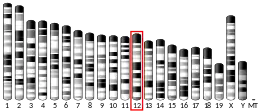CBLL1
The E3 ubiquitin-protein ligase Hakai (HAKAI) also known as Casitas B-lineage lymphoma-transforming sequence-like protein 1 (CBLL1) is an enzyme that in humans is encoded by the CBLL1 gene.[5] This gene encodes an E3 ubiquitin ligase for the E-cadherin complex and mediates its ubiquitination, endocytosis, and degradation in the lysosomes. The encoded protein contains a RING-finger domain and is also thought to have a role in control of cell proliferation.
| CBLL1 | |||||||||||||||||||||||||||||||||||||||||||||||||||
|---|---|---|---|---|---|---|---|---|---|---|---|---|---|---|---|---|---|---|---|---|---|---|---|---|---|---|---|---|---|---|---|---|---|---|---|---|---|---|---|---|---|---|---|---|---|---|---|---|---|---|---|
| |||||||||||||||||||||||||||||||||||||||||||||||||||
| Identifiers | |||||||||||||||||||||||||||||||||||||||||||||||||||
| Aliases | CBLL1, HAKAI, RNF188, Cbl proto-oncogene like 1 | ||||||||||||||||||||||||||||||||||||||||||||||||||
| External IDs | OMIM: 606872 MGI: 2144842 HomoloGene: 11734 GeneCards: CBLL1 | ||||||||||||||||||||||||||||||||||||||||||||||||||
| |||||||||||||||||||||||||||||||||||||||||||||||||||
| |||||||||||||||||||||||||||||||||||||||||||||||||||
| |||||||||||||||||||||||||||||||||||||||||||||||||||
| |||||||||||||||||||||||||||||||||||||||||||||||||||
| |||||||||||||||||||||||||||||||||||||||||||||||||||
| Wikidata | |||||||||||||||||||||||||||||||||||||||||||||||||||
| |||||||||||||||||||||||||||||||||||||||||||||||||||
Function
Hakai functions as a RING finger domain-containing E3 ubiquitin ligase for E-cadherin. Hakai mediates E-cadherin ubiquitination and its degradation by proteasomes. "Hakai" means "destruction" in Japanese. Proteosomal degradation of E-cadherin can be regulated by phosphorylation. The Hakai binding site is a part of the E-cadherin cytoplasmic domain that contains several tyrosines.[6] Tyrosine kinases such as Src and Met can phosphorylate E-cadherin and enhance Hakai binding to E-cadherin.[7] Two lysines of the E-cadherin cytoplasmic domain have been shown to be sites for ubiquitination.[8] Hakai also interacts with polypyrimidine tract-binding protein-associated splicing factor.[9]
See also
- CBL (gene); the gene name "CBLL1" comes from "Cbl-like protein 1"
References
- GRCh38: Ensembl release 89: ENSG00000105879 - Ensembl, May 2017
- GRCm38: Ensembl release 89: ENSMUSG00000020659 - Ensembl, May 2017
- "Human PubMed Reference:". National Center for Biotechnology Information, U.S. National Library of Medicine.
- "Mouse PubMed Reference:". National Center for Biotechnology Information, U.S. National Library of Medicine.
- Fujita Y, Krause G, Scheffner M, Zechner D, Leddy HE, Behrens J, Sommer T, Birchmeier W (Mar 2002). "Hakai, a c-Cbl-like protein, ubiquitinates and induces endocytosis of the E-cadherin complex". Nature Cell Biology. 4 (3): 222–31. doi:10.1038/ncb758. PMID 11836526. S2CID 40423770.
- Aparicio LA, Valladares M, Blanco M, Alonso G, Figueroa A (Jun 2012). "Biological influence of Hakai in cancer: a 10-year review". Cancer and Metastasis Reviews. 31 (1–2): 375–86. doi:10.1007/s10555-012-9348-x. PMC 3350634. PMID 22349934.
- Mukherjee M, Chow SY, Yusoff P, Seetharaman J, Ng C, Sinniah S, Koh XW, Asgar NF, Li D, Yim D, Jackson RA, Yew J, Qian J, Iyu A, Lim YP, Zhou X, Sze SK, Guy GR, Sivaraman J (Mar 2012). "Structure of a novel phosphotyrosine-binding domain in Hakai that targets E-cadherin". The EMBO Journal. 31 (5): 1308–19. doi:10.1038/emboj.2011.496. PMC 3298002. PMID 22252131.
- Hartsock A, Nelson WJ (2012). "Competitive regulation of E-cadherin juxtamembrane domain degradation by p120-catenin binding and Hakai-mediated ubiquitination". PLOS ONE. 7 (5): e37476. Bibcode:2012PLoSO...737476H. doi:10.1371/journal.pone.0037476. PMC 3365061. PMID 22693575.
- Figueroa A, Fujita Y, Gorospe M (Nov 2009). "Hacking RNA: Hakai promotes tumorigenesis by enhancing the RNA-binding function of PSF". Cell Cycle. 8 (22): 3648–51. doi:10.4161/cc.8.22.9909. PMC 2808762. PMID 19855157.
External links
- Human CBLL1 genome location and CBLL1 gene details page in the UCSC Genome Browser.
This article incorporates text from the United States National Library of Medicine, which is in the public domain.



